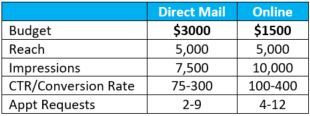

Do your eyes gloss over when you hear online marketing terms like reach and impressions? Basically, it’s just lingo to differentiate your ad’s effectiveness. If you’re spending time creating an ad to reach a specific demographic, you can bet your bottom dollar you want to know if the ad is working or not. Each social media platform defines reach and impressions a bit differently so here’s a mini crash course on the two terms.
What is reach? (Think people)
Reach refers to the number of unique people who have seen your ad.
If 100 different people saw your ad, your ad’s reach is 100. If many different users saw your ad, it had a broad reach, which in turn means the ad had more engagement and shares among other users, which is very desirable. If your reach was broad, but your ad had no conversions (for example, no link clicks, shares, likes, etc.), you need to revise the ad’s content so it resonates with your readers.
Reach is easier to understand if you compare it to direct mail. You send out 5,000 pieces of direct mail. Your reach is 5,000 people.
What are impressions? (Think ad displays)
Impressions are the number of times your ad displays on a screen – that is, how many times your ad was delivered to someone’s feed.
If your ad had 100 impressions, it means the ad popped up on users’ screens and was seen 100 times. Have you ever been annoyed by seeing an ad appear over and over again on your screen? Your potential have patients have too! Therefore, it’s important to track your impressions so you don’t burden your audience with too many ads. On the other hand, low impressions can reveal an error with your ad so you can correct it in the early stages.
Impressions are easier to understand if you compare them to direct mail. You send out 5,000 pieces of direct mail, everyone reads the piece once and 1,000 people read it it twice. Your impression count would be 6,000.
Why track both impressions and reach?
Impressions and reach tell you different things about your ad’s performance, and you need both to assess the effectiveness of a campaign.
- As reach increases, it leads to greater awareness. It’s important to determine your advertising budget first and maximize your ad’s reach to your target market within your budget limits.
- Pay attention to any shares, likes or comments on your ad. This helps you find potential clients, which in turn, will extend your reach and increase your impressions.
- Remember that both reach and impressions drive people to take action. Think about how to increase engagement in your ads and this will undoubtedly increase reach and impressions.
So what does this mean for you…the advertiser?
Take a look at the sample below, it compares a direct mail campaign to an online campaign using average online response rates from a recent online program we worked on. As you can see, digital advertising can be very cost-effective.

REMEMBER the best marketing strategy is a smart combo of digital and print advertising. You need both to market effectively.
- The Role of Reviews in Your Businesss Success - March 17, 2022
- Build Your Brand with PPC - October 3, 2019
- Narrow Your Market: Less Is More - August 12, 2019
